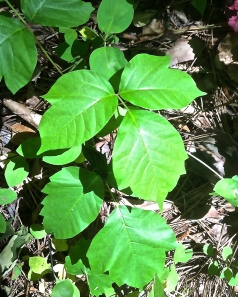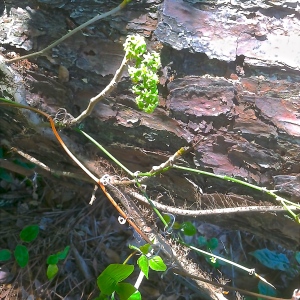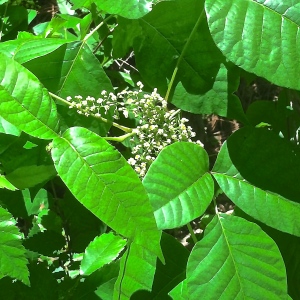pon·der – to think about or consider (something) carefully
Spend any amount of time in the outdoors or in your yard, it’s very likely you’ll come in contact with this evil plant. It has successfully reduced men, women, and children to miserable, scratching beasts.
Time in nature has a calming, rejuvenating effect on people… until they feel Nature’s revenge.
Over the years I’ve sought out home remedies to stop the painful, blistering rash caused by poison ivy. In my experience, some work, some don’t. In extreme cases, I’ve gotten steroid shots. Like the time I transferred the oil to my nether region while relieving myself in the woods – the week before getting married! An injection of steroids was my top priority. LOL!
It’s ironic that this poisonous vine is in the family of my favorite nut, the cashew. I eat a handful daily with no reaction. What makes the ivy, oak, or sumac poisonous to humans is the dreaded oil… urushiol (you-ROO-shee-ol). All parts of the plant contain the oil which can stay active for up to five years. Once the oil makes contact with your skin – via touching the plant directly or indirect contact from clothing, shoes, or your pet – the clock starts ticking for a red, itchy, bubbly rash to occur within 12 to 72 hours.
Some people swear they are immune to this stuff. I’ve personally witness a buddy of mine hug a pine tree covered in poison ivy with no ill effects. The theory of some people being immune is suspect in my mind. WARNING: If you are one of those fortunate individuals who have rolled in this stuff and never experienced a reaction, you may be a candidate for hospitalization in the future. Stories exist of people who thought they were immune but found out the hard way they were not. The more times you come in contact with the oil, the more likely your are to come down with a rash.
Attempting to build immunity to poison ivy is not a new idea. Tales of Native Americans eating leaves in early spring to build resistance , true or not, is not something I’ve tried or recommend.
Stuff to Avoid
The best remedy for poison ivy is AVOIDANCE. That’s not always easy. The oil is potent and stable. Taking off shoes after hiking or petting your dog who stares at you wagging and waiting for affection can transfer urushiol. Doing exposed laundry or handling outdoor tools – same effect. Imagine unknowingly spreading the oil in a sleeping bag – and re-infecting yourself two more times by sleeping in the bag a year later!! You can read more stories of creatively contracting the rash here. Horrific photos of poison ivy victims can be viewed in the Skin Rash Hall of Fame. This stuff is nothing to play with!
Avoid anything that would make the oil go airborne like burning wood contaminated with poison ivy. Lawn mowers and weed trimmers have a way of spreading the wealth.
Leaves of Three
Leaves of three, let it be! Poison ivy and oak have three-leaf clusters. Poison ivy and oak are very similar and not worth making a distinction between the two. They’re both bad news!
Leaves of three!
Avoid ‘hairy’ vines climbing on trees
Poison ivy about to bloom
Poison sumac, on the other hand, is a shrub that has 7 to 13 leaves on a branch and is found mostly in wet, swampy areas.
I Need a Remedy!
If you know you’ve come in contact with urushiol, wash the area of skin with cold water and non-oil based soap. Hot water opens skin pores to allow more poison oil in. An industrial soap like Fels Naptha is good to keep on hand or in your bushcraft/camping kit. No soap? Water is better than nothing. Once the oil bonds to the skin, no amount of washing will help.
While I haven’t tried all the folk remedies listed below, they may work for you. If so, please let other readers know. Also, you may have a cure that we haven’t listed. By all means, please share!
Herbal Remedies
- Jewelweed – Apply the juice to affected area. The natural soaps in this weed are thought to be responsible for healing blisters in 2 to 3 days. How to identify and use jewelweed for skin rashes can be found here.
- Tea Tree Oil – Apply every two hours to stop itching and dry the blisters and rash.
- Honey suckle leaves – Blend leaves 3:1 with water. Strain and apply to affected area liberally.
- Plantain – The drawing properties of this weed helps with bites and poisonous plants. Apply a poultice twice daily.
- Aloe vera plant is known for burn relief but can be used for poison ivy as well
Kitchen/Bath Remedies
- Fels Naptha soap is excellent stuff for removing urushiol
- Baking soda paste and bath
- Oatmeal paste and bath
- White vinegar
- Salt rubbed into the rash and used in baths
- Banana peel (inside) rubbed on rash – from Foxfire books
- Tomato juice bath with salt
- Immediately after contact, wash with cold water and dishwashing soap which cuts grease… and urushiol
- Some like it HOT! Hot water treatment – run hot water (hot as you can stand without scalding) on affected area for itch relief
- Hair blow dryer – same idea as hot water treatment above.
- Vicks VapoRub – temporary relief from itching
- Rubbing alcohol misted on areas
- Bleach – I don’t recommend this but people use it on their skin
- Ban roll on anti-perspirant – the plain, non-scented stuff
Medicine Cabinet Conventional Remedies
- Witch Hazel
- Over the counter poison ivy meds
- Goldbond medicated cream
- Epsom salt bath soak
- Milk of Magnesia – add layers to affected area for itch and drying
- Preparation H
Clean Your Stuff
Now that you know you have the rash, it’s vital that you clean clothing, bedding, tools, shoes, and pets that can further spread the toxic oil. You don’t want to share the love with others or re-infect after you’re cured. Urushiol the size of a pin head can infect 500 people. It’s potent stuff!
First, the oil is what causes the rash. It’s not spread by draining blisters to other body parts or people. It is systemic in highly allergic people and can spread to other body parts. The culprit is usually oil on or under finger nails that causes the rash to spread. Avoid touching sensitive areas if you knowingly touched the plant oil.
Wash clothes and bedding several times. The first few days after exposure, shower in cold water several times a day with a non-oil based soap. Oily soap helps spread the urushiol. You want to completely rid the oil from your body. This may sound like overkill but better safe than itchy.
Wipe down tools and gear with alcohol or using rubber gloves. Anything you may have touched before may hold the oil – steering wheel, light switch, door knobs, tool handle, etc. I carry a flask of Everclear in my bushcraft kit for medicinal reason and disinfection.
Trade Theory for Action
Not every remedy works for everybody. We’re individuals and our body chemistries are different. What works for me may not for you. Besides avoidance, what conventional or folk remedy have you found effective to rid the rash?
Keep Doing the Stuff,
Todd
P.S. – You can also keep up with the Stuff we’re Doing on Twitter, Pinterest, Google +, and our Facebook page… and over on the Doing the Stuff Network on Pinterest, Google +, and Facebook.
P.P.S – If you find value in our blog, Dirt Road Girl and I would appreciate your vote on the Top Prepper Sites! You can vote daily by clicking here or on the image below. Check out all the other value-adding Prepper sites while you’re there…




